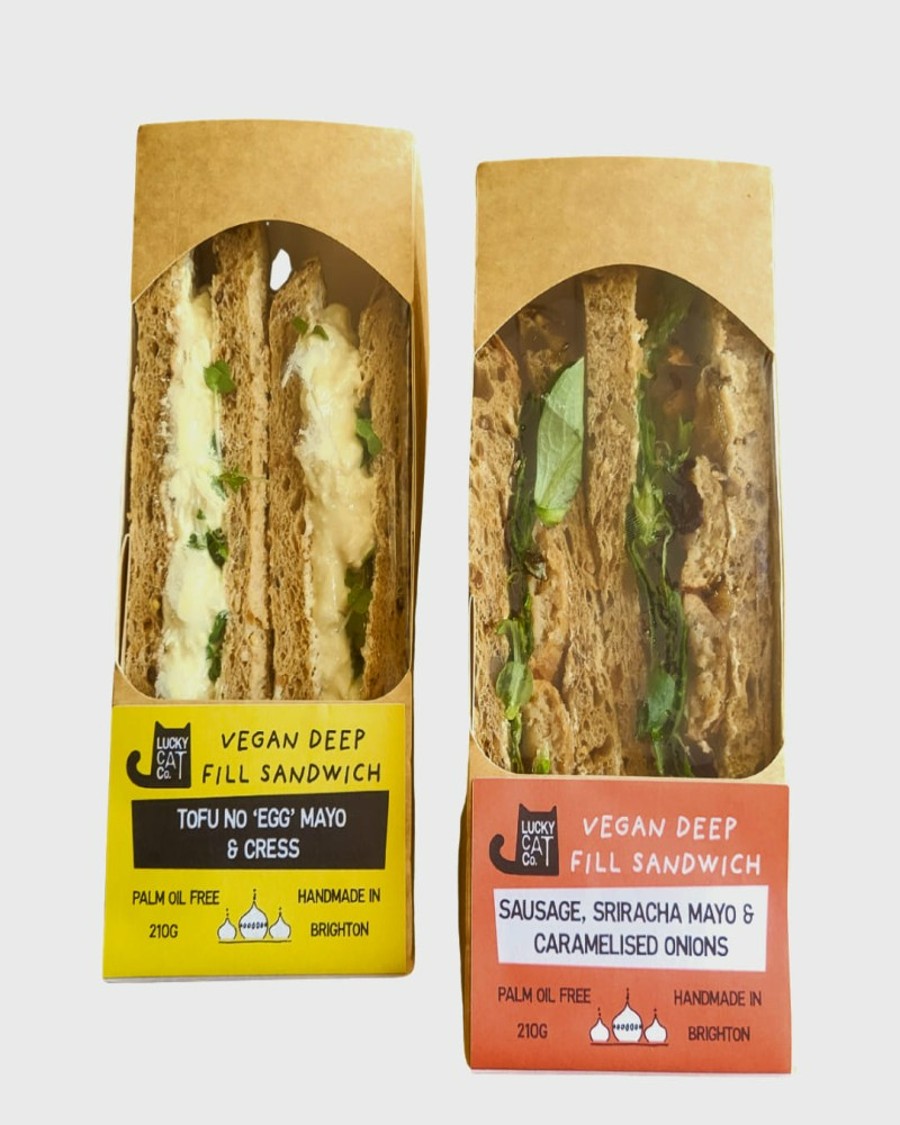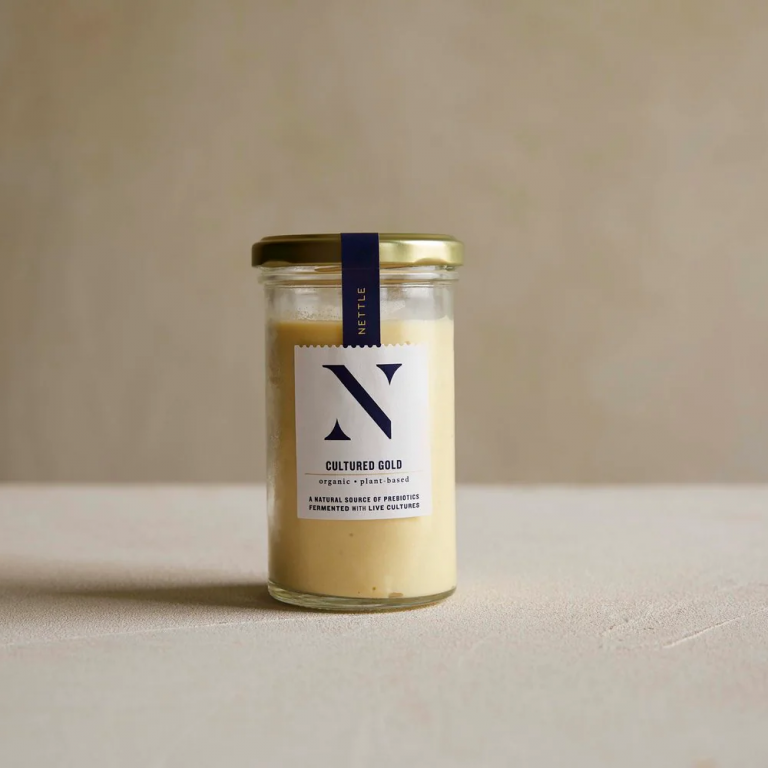
Brighton’s Kindly supermarket sells sandwiches in compostable boxes.
Plastic waste is a serious issue, especially in the food industry where single-use plastics are everywhere. Sandwich shops and delis often rely on plastic packaging and utensils, which add up to a large amount of waste every day.
A simple sandwich can make your day brighter, and so can small choices that help the planet. More sandwich shops are swapping plastic bags for plastic-free options. These changes mean less waste and a lighter footprint with every takeaway.
Willow’s Choice is the eco alternative to clingfilm, made from bagasse (sugar cane waste). Sold with an easy-to-use dispenser and cutter (just like normal clingfilm), this is the perfect swap for people who wrap and sell sandwiches to the public. It’s also okay for freezer sand microwaves.
Once bought, you just buy refill rolls to fit the dispenser. And you can also buy biodegradable bagasse gloves, for hygienically handling food, in accordance with laws.
To store food, you may be interested in Agreena, a reusable silicone alternative to clingfilm (that also replaces foil) to wash and use again. Sold on a roll, silicone does contain fossil fuels (mixed with sand) but lasts for years and at end of life, is easily recycle.
It also can withstand high temperatures, and stretches over glass, to keep prepped foods in the fridge fresh.
If You Care offers snack and sandwich bags that are greaseproof (so ideal for buttered sandwiches, nuts, potato chips or cookies) along with mayonnaise and oil. Made in Sweden from unbleached spruce tree pulp, they are also okay for microwaves.
Unlike most sandwich bags, these are plastic-free and not treated with petroleum or soy wax. Chlorine-free too, so no poisons dumped into our lakes, rivers and streams. The same company sells plastic-free waxed paper that is great for food prep, and also for keeping cheese or vegan cheese in the fridge.
Identifying Plastic Waste Sources
Before swapping out plastics for sustainable options, it helps to pinpoint exactly where plastics are most common in sandwich shops and delis. Plastics sneak in through numerous daily uses, building up to a significant environmental problem. Knowing the main sources lets you tackle the biggest waste offenders first, making your efforts both practical and impactful.
Packaging Materials
Plastic packaging dominates many sandwich shops. Sandwich wrappers, cling films, and deli containers often use clear or coloured plastic that keeps food fresh and visible but becomes waste after a single use. While convenient, these wrappers usually go straight into bins or recycling with limited reuse.
Takeout boxes commonly rely on plastic or are coated with plastic lining to prevent leaks, but they are hard to recycle and often end up in landfill. Plastic bags, used for carrying orders, add to the problem as they frequently get discarded immediately after use.
Disposable Cutlery and Utensils
Forks, knives, spoons and stirrers made from plastic are a common sight in delis and sandwich shops, especially those with takeaway options. These items are typically single-use and discarded shortly after eating. Unlike reusable metal or wooden utensils, plastic ones do not break down quickly and contribute heavily to litter.
Straws and Drink Accessories
Although straws may seem small, they create a surprisingly large portion of plastic waste from food outlets. Many customers use plastic straws with their drinks, and they rarely get recycled properly. Other drink accessories such as plastic lids and cup sleeves contribute to the amount of single-use plastic in daily operations.
Condiment Sachets and Single-Use Portion Packs
Ketchup, mayonnaise, mustard and other condiments often come in tiny plastic sachets or tubs. These packaging formats are convenient for portion control and hygiene but generate waste that is usually not recyclable. Such sachets add to the pile of plastic trash collected after every busy lunch period.
Food Prep and Display Items
In some delis, pre-portioned ingredients or toppings may be stored or served in plastic containers or trays. Plastic wrap used to cover salads, sliced meats or cheese at counters also adds to daily plastic use. Even plastic gloves worn by staff in food prep and service increase overall plastic consumption.
Customer Disposal Habits
Plastic waste from shops often depends on how customers dispose of used items. When bins for recycling plastics are not clearly marked or available, customers tend to throw plastic wrappers, cutlery and containers in general waste. This limits recycling rates and encourages more plastic production.
Plastic-Free Packaging Alternatives
Finding the right packaging to replace plastic without sacrificing convenience or food quality is a key step on the path to cutting waste. Thankfully, there are several options that combine eco-friendliness with durability and customer appeal.
From compostable materials that break down naturally to reusable containers that keep packaging out of bins altogether, here’s an overview of effective packaging choices for sandwich shops and delis looking to ditch plastic.
Compostable and Biodegradable Materials
A popular option is to use compostable and biodegradable packaging, which offers a responsible way to serve food while shrinking waste impact. These materials safely break down under the right conditions, returning to the environment without leaving harmful residues.
Some common choices include:
- PLA (Polylactic Acid): Made from plant starch such as corn, PLA is a clear, plastic-like material often used for lids, cups, and sandwich wrappers. It looks and behaves like plastic but breaks down in industrial composting. It’s important customers and shops send PLA packaging to certified composting facilities since PLA won’t degrade properly in landfill.
- Bagasse: This is a fibrous by-product of sugarcane processing. Bagasse containers and trays are sturdy, heat-resistant, and compostable. They handle oils and moisture well, making them ideal for sandwiches, salads, or hot meals. Bagasse breaks down quickly in home compost or commercial facilities.
- Cornstarch-based products: Used for trays and cutlery, cornstarch is another plant-derived material that biodegrades quickly in industrial or home composting setups. It’s less flexible than plastic but good for holding dry items or dry foods.
When choosing these materials, it’s key to:
- Check local composting options to avoid contamination in recycling or landfill.
- Clearly label packaging with disposal instructions to guide customers.
- Consider the transportation distance and environmental cost of sourcing materials.
On the plus side, compostable packaging often offers a rustic, natural look which appeals to environmentally aware customers. It plays well with the ethos of fresh, wholesome ingredients seen in many delis and sandwich spots. While costs may be slightly higher than plastic, the environmental return favours these options when managed correctly.
Reusable Packaging and Discounts
Another step beyond disposable materials is adopting reusable packaging to eliminate single-use waste. This approach puts less strain on waste systems and can build customer loyalty.
Here’s how sandwich shops and delis can encourage customers to switch to reusables:
- Offer sturdy containers to customers, made from stainless steel, silicone, or durable plastic alternatives designed for many uses. These containers keep food fresh and can withstand repeated washing.
- Set up a return or refill system. Customers bring their containers back for refills or clean replacements, reducing packaging waste each time. Shops can implement clear hygiene protocols to ease concerns around food safety.
- Create loyalty programmes that reward customers who bring their own containers. Discounts, points, or small freebies offer a tangible incentive to choose reusable options. Even a simple 10% off can encourage habit change.
- Sell branded reusable packaging as part of your shop’s identity. It’s a win-win: customers get practical containers, and shops reinforce their sustainability status.
Many places find that combining reusable containers with compostable disposables for people who forget containers covers all bases. This gives customers a choice while maintaining the zero-plastic goal.
Switching to reusables saves on packaging costs in the long run and reduces the carbon footprint linked to making, transporting, and disposing of single-use plastic. It also creates a community feel, as returning customers actively participate in reducing waste.
By focusing on compostable materials and reusable packaging, sandwich shops and delis can cut plastic waste in a way that feels natural and doable. These options contribute to a cleaner environment and a fresher brand image, helping shops stand out while doing their part.
Eliminating Plastic in Food Service
Reducing plastic use in sandwich shops and delis isn’t limited to packaging alone. Food service items like cutlery, straws, and even food displays add up to a significant portion of plastic waste. Finding smart, practical alternatives that keep operations smooth and customers happy is key. Let’s start by looking at how to present and display your food in ways that cut plastic without losing style or safety.
Sustainable Menu Presentation and Display
Switching from plastic to more sustainable materials for menus and food displays can make a big difference, both visually and environmentally. Instead of using plastic covers or signs, consider options that offer durability, cleanliness, and style, while reducing plastic waste.
Glass covers are a great alternative to plastic lids for displaying sandwiches, salads, or deli items. They protect food from contamination and keep it fresh, just like plastic, but without creating waste after use. Glass is easy to clean and doesn’t absorb odours or stains, keeping displays looking crisp and inviting. Customers often respond well to glass displays because they feel more hygienic and upscale.
Beyond covers, look at the way menu boards and signs are presented. Plastic signs can be swapped for materials like:
- Recycled cardboard or kraft paper, which can be refreshed daily or swapped out easily and recycled after use.
- Wooden or bamboo frames which add a natural, warm touch and can be reused for a long time.
- Chalkboards or whiteboards, which allow daily updates without any waste and provide a charming, personalised feel.
Using these materials not only reduces plastic but adds to your shop’s character, giving it a fresh, eco-conscious image. Cleanliness and food safety remain robust since glass and wipeable boards can be sanitised quickly and regularly.
In a way, choosing sustainable display options is like dressing your food not only to protect it but also to tell customers your shop cares about quality inside and out. It enhances the overall dining experience while shrinking your plastic footprint.
Practical Implementation and Staff Training
Moving away from plastic is more than swapping materials; it means changing habits and routines throughout your sandwich shop or deli. The success of going plastic-free depends on how well your team adapts to new products and procedures. This section gives practical advice on putting plastic-free solutions into action and helping your staff get comfortable with the changes.
Introducing New Materials to Your Team
When you switch from plastic to alternative materials, your staff will be the first to handle these changes. Start by explaining why the shift matters, so everyone understands the bigger picture behind the new packaging, cutlery, or wraps. People are more likely to support changes if they know the environmental benefits and how it fits with your shop’s values.
- Showcase the benefits: Share how compostable containers or reusable boxes help reduce waste and improve your shop’s image.
- Offer clear handling instructions: Some materials, like bagasse trays or PLA wrappers, behave differently than plastic. Staff need to know how to store, use, and dispose of these items correctly to keep food fresh and prevent damage.
Staff Training for Waste Management and Sorting
Plastic-free operations often involve new routines for waste sorting and disposal. Your staff must learn how to separate compostable packaging, recyclables, and trash effectively. Provide straightforward training sessions and simple waste station setups to make this easy.
- Use visual aids: Colour-coded bins with labels and pictures speed up sorting and reduce contamination.
- Run practice drills: Regular team exercises help embed the waste segregation process.
- Empower staff: Encourage them to guide customers about where to dispose of packaging properly.
Engaging Staff with Hands-On Practice
Practical training is the best way for your team to gain confidence with new materials. Arrange trial runs during quiet times, allowing staff to familiarise themselves with packing sandwiches, loading containers, or using new utensils.
You might set up:
- Workshops with suppliers who can demonstrate how to use and clean reusable containers or compostable cutlery.
- Role-playing customer interactions around explaining the plastic-free effort and disposal instructions.
- Feedback sessions where staff share what works well and any challenges they face.
Sourcing Sustainable Suppliers
Finding reliable suppliers for eco-friendly products is part of making plastic-free work well. Look for vendors who can supply consistent quality compostable materials, reusable containers, and natural packaging at a manageable cost. Local suppliers may offer faster restocking and reduce shipping emissions.
Keep an eye on:
- Product certifications (e.g., compostability or biodegradability labels)
- Minimum order sizes and delivery options
- Customer support for training and troubleshooting
Measuring Your Environmental Progress
Tracking your waste reduction keeps your team motivated and shows customers the results of your efforts. Set simple metrics to monitor your plastic-free journey, such as:
- Amount of plastic waste diverted monthly
- Volume of compostable packaging used versus traditional plastic
- Percentage of customers opting for reusable containers or bringing their own
Share these results regularly with your team and customers. This transparency builds trust and keeps everyone focused on continuous improvement.






